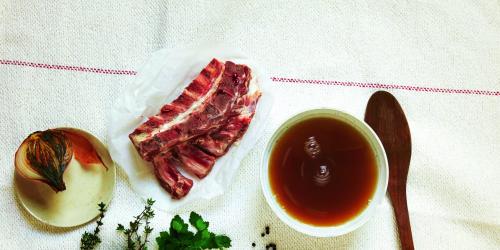Horseradish description
From the brassicaceae family, like cabbage, turnip or watercress, horseradish is a perennial that is grown for its long, tubular root. Grated, horseradish root is a condiment widely used in the culture of Central Europe and Germany. In France, Alsatians use it to accompany sauerkraut and red cabbage salad. Substitute for mustard, it brings its pungent flavor to raise bland dishes. Unlike pepper, the spicy taste of horseradish disappears between each bite. Even if they are close, the horseradish is to differentiate wasabi: of the same family, these 2 roots often decorate the Asian cooking. The most famous form is the famous green wasabi paste, which is eaten with sushi, also called Japanese mustard.
Horseradish: a champion of vitamin C
Real concentrated energy, horseradish root is known to provide an excellent dose of vitamin C. Since it is consumed usually in small quantities, it is a complement to add to the daily menus to enjoy its benefits. Vitamin C is essential to the body and participates in various metabolic processes: in addition to its ability to provide an almost immediate boost, it maintains healthy bones and cartilage, prevents infections and helps healing. Major antioxidant, vitamin C contained in horseradish is a perfect protection against free radicals found in the diet or in the UV rays. The latter are responsible for, among other things, skin aging and the development of cardiovascular diseases and cancers.
Other antioxidants from horseradish
Like all crucifers and brassicas, horseradish is a perfect source of antioxidants. In addition to vitamin C present in quantity, studies have found traces of flavonoids recognized as active complexes against oxidative stress. The manganese and copper also contained in horseradish root develop their antioxidant action on the protective membranes of the cells of the body. They are also involved in the formation of hemoglobin and collagen which protects the connective tissues of the body and tissues. Finally, horseradish contains iron which, in collaboration with vitamin C, is better absorbed by metabolism. Iron is essential for the formation of red blood cells and the transport of oxygen in the blood.
Horseradish: vitamins and trace elements
Horseradish root offers a very wide spectrum of different trace elements and vitamins essential for the proper functioning of the body. Even if they are represented in a small quantity, these nutrients propose a range of actions on different processes of exchange: consumed raw, horseradish contains calcium which contributes to maintain the bones and the teeth. Phosphorus also acts on calcification and participates in the regeneration of tissues. With a good dose of potassium, horseradish affects digestion, making it a particularly effective element on lazy transits. Zinc helps to strengthen the immune system. Its impressive intake of different vitamins from the B group makes it a vital boosting condiment. Horseradish root helps energize the body and stimulate natural defenses. Vitamin B1 contributes to normal growth of muscles and organs, vitamin B2 contributes to tissue restoration and red blood cell formation, and vitamin B6 helps red blood cells to carry more oxygen.
From the brassicaceae family, like cabbage, turnip or watercress, horseradish is a perennial that is grown for its long, tubular root. Grated, horseradish root is a condiment widely used in the culture of Central Europe and Germany. In France, Alsatians use it to accompany sauerkraut and red cabbage salad. Substitute for mustard, it brings its pungent flavor to raise bland dishes. Unlike pepper, the spicy taste of horseradish disappears between each bite. Even if they are close, the horseradish is to differentiate wasabi: of the same family, these 2 roots often decorate the Asian cooking. The most famous form is the famous green wasabi paste, which is eaten with sushi, also called Japanese mustard.
Horseradish: a champion of vitamin C
Real concentrated energy, horseradish root is known to provide an excellent dose of vitamin C. Since it is consumed usually in small quantities, it is a complement to add to the daily menus to enjoy its benefits. Vitamin C is essential to the body and participates in various metabolic processes: in addition to its ability to provide an almost immediate boost, it maintains healthy bones and cartilage, prevents infections and helps healing. Major antioxidant, vitamin C contained in horseradish is a perfect protection against free radicals found in the diet or in the UV rays. The latter are responsible for, among other things, skin aging and the development of cardiovascular diseases and cancers.
Other antioxidants from horseradish
Like all crucifers and brassicas, horseradish is a perfect source of antioxidants. In addition to vitamin C present in quantity, studies have found traces of flavonoids recognized as active complexes against oxidative stress. The manganese and copper also contained in horseradish root develop their antioxidant action on the protective membranes of the cells of the body. They are also involved in the formation of hemoglobin and collagen which protects the connective tissues of the body and tissues. Finally, horseradish contains iron which, in collaboration with vitamin C, is better absorbed by metabolism. Iron is essential for the formation of red blood cells and the transport of oxygen in the blood.
Horseradish: vitamins and trace elements
Horseradish root offers a very wide spectrum of different trace elements and vitamins essential for the proper functioning of the body. Even if they are represented in a small quantity, these nutrients propose a range of actions on different processes of exchange: consumed raw, horseradish contains calcium which contributes to maintain the bones and the teeth. Phosphorus also acts on calcification and participates in the regeneration of tissues. With a good dose of potassium, horseradish affects digestion, making it a particularly effective element on lazy transits. Zinc helps to strengthen the immune system. Its impressive intake of different vitamins from the B group makes it a vital boosting condiment. Horseradish root helps energize the body and stimulate natural defenses. Vitamin B1 contributes to normal growth of muscles and organs, vitamin B2 contributes to tissue restoration and red blood cell formation, and vitamin B6 helps red blood cells to carry more oxygen.


